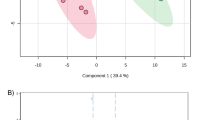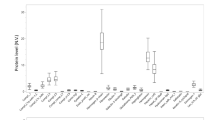Abstract
Background
Type 2 diabetes mellitus (T2DM), also known as adult-onset diabetes or noninsulin-dependent diabetes mellitus, is characterized by hyperglycemia and insulin resistance. Protein biomarker screening plays an essential role in different diseases. Proteomic methods such as MALDI-TOF based peptide mass fingerprinting, LC-MS/MS based peptide sequencing, and multidimensional liquid phase chromatography (MDLC) coupled with tandem mass spectrometry (MS) shotgun proteomics are used to identify biomarkers.
Methods
In this study, we used a MDLC coupled with tandem MS shotgun proteomic method to demonstrate protein quantitation results by comparing human serum samples from T2DM patients with those of healthy subjects. We utilized quantitative techniques, dimethyl labeling, MDLC by hydrophilic interaction liquid chromatography separated column, and reverse-phase high-performance liquid chromatography coupled with tandem MS to identify proteins with high potential to be T2DM biomarker candidates.
Results
Identified candidates included vitamin D–binding protein, apolipoprotein B-100, apolipoprotein A2, apolipoprotein A1, transthyretin, Ig heavy-chain V–III region BRO, antithrombin-3, fibrinogen gamma chains, fibrinogen alpha chains, and alpha-1-antitrypsin. In addition, we also generated relative protein networks using STRING bioinformatic software.
Conclusion
These potential biomarker candidates might be verified by further experiments such as an ELISA assay or multiple reaction monitoring MS screening.





Similar content being viewed by others
References
Gardner D, Shoback D. Greenspan’s basic & clinical endocrinology. New York: McGraw-Hill Professional; 2011.
Lu JF, Hsiao WC. Does universal health insurance make health care unaffordable? Lessons from Taiwan Health Aff (Millwood). 2003;22:77–88.
Hwang SJ, Tsai JCChen HC. Epidemiology, impact and preventive care of chronic kidney disease in Taiwan. Nephrology (Carlton). 2010;15(Suppl 2):3–9.
Qaseem A, Humphrey LL, Sweet DE, et al. Oral pharmacologic treatment of type 2 diabetes mellitus: a clinical practice guideline from the American College of Physicians. Ann Intern Med. 2012;156:218–31.
Miura A, Yamagata K, Kakei M, et al. Hepatocyte nuclear factor-4alpha is essential for glucose-stimulated insulin secretion by pancreatic beta-cells. J Biol Chem. 2006;281:5246–57.
Wu Y, Li H, Loos RJ, et al. Common variants in CDKAL1, CDKN2A/B, IGF2BP2, SLC30A8, and HHEX/IDE genes are associated with type 2 diabetes and impaired fasting glucose in a Chinese Han population. Diabetes. 2008;57:2834–42.
Christian P, Stewart CP. Maternal micronutrient deficiency, fetal development, and the risk of chronic disease. J Nutr. 2010;140:437–45.
Herder C, Roden M. Genetics of type 2 diabetes: pathophysiologic and clinical relevance. Eur J Clin Invest. 2011;41:679–92.
Mao P, Wang D. Top-down proteomics of a drop of blood for diabetes monitoring. J Proteome Res. 2014;13:1560–9.
Bhonsle HS, Korwar AM, Chougale AD, et al. Proteomic study reveals downregulation of apolipoprotein A1 in plasma of poorly controlled diabetes: a pilot study. Mol Med Rep. 2013;7:495–8.
Scott EM, Carter AMFindlay JB. The application of proteomics to diabetes. Diab Vasc Dis Res. 2005;2:54–60.
Riaz S, AlamSSAkhtar MW. Proteomic identification of human serum biomarkers in diabetes mellitus type 2. J Pharm Biomed Anal. 2010;51:1103–7.
O’Seaghdha CM, Hwang SJ, Larson MG, et al. Analysis of a urinary biomarker panel for incident kidney disease and clinical outcomes. J Am Soc Nephrol. 2013;24:1880–8.
Bateman RJ, Xiong C, Benzinger TL, et al. Clinical and biomarker changes in dominantly inherited Alzheimer’s disease. N Engl J Med. 2012;367:795–804.
Chiou SH, Wu CY. Clinical proteomics: current status, challenges, and future perspectives. Kaohsiung J Med Sci. 2011;27:1–14.
Kline KG, Finney GLWuCC. Quantitative strategies to fuel the merger of discovery and hypothesis-driven shotgun proteomics. Brief Funct Genomic Proteomic. 2009;8:114–25.
Lyons TJ, Basu A. Biomarkers in diabetes: hemoglobin A1c, vascular and tissue markers. Transl Res. 2012;159:303–12.
Yassine H, Borges CR, Schaab MR, et al. Mass spectrometric immunoassay and MRM as targeted MS-based quantitative approaches in biomarker development: potential applications to cardiovascular disease and diabetes. Proteomics Clin Appl. 2013;7:528–40.
Hsu JL, Huang SY, Chow NH, et al. Stable-isotope dimethyl labeling for quantitative proteomics. Anal Chem. 2003;75:6843–52.
Kuo CJ, Liang SS, Hsi E, et al. Quantitative proteomics analysis of varicose veins: identification of a set of differentially expressed proteins related to ATP generation and utilization. Kaohsiung J Med Sci. 2013;29:594–605.
Ficarro SB, Zhang Y, Carrasco-Alfonso MJ, et al. Online nanoflow multidimensional fractionation for high efficiency phosphopeptide analysis. Mol Cell Proteomics. 2011;10:O111-011064.
Olsen JV, de Godoy LM, Li G, et al. Parts per million mass accuracy on an Orbitrap mass spectrometer via lock mass injection into a C-trap. Mol Cell Proteomics. 2005;4:2010–21.
Franceschini A, Szklarczyk D, Frankild S, et al. STRING v9.1: protein-protein interaction networks, with increased coverage and integration. Nucleic Acids Res. 2013;41:D808-815.
Motoyama A, Yates JR 3rd. Multidimensional LC separations in shotgun proteomics. Anal Chem. 2008;80:7187–93.
McDonald WH, Yates JR 3rd. Shotgun proteomics and biomarker discovery. Dis Markers. 2002;18:99–105.
Liang SS, Liao WT, Kuo CJ, et al. Phthalic acid chemical probes synthesized for protein-protein interaction analysis. Int J Mol Sci. 2013;14:12914–30.
Ficarro SB, Zhang Y, Carrasco-Alfonso MJ, et al. Online nanoflow multidimensional fractionation for high efficiency phosphopeptide analysis. Molecular & Cellular Proteomics. 2011;10:O111-011064.
Safarpour P, Daneshi-Maskooni M, Vafa M, et al. Vitamin D supplementation improves SIRT1, irisin, and glucose indices in overweight or obese type 2 diabetic patients: a double-blind randomized placebo-controlled clinical trial. BMC Fam Pract. 2020;21:26.
Hajhashemy Z, Shahdadian F, Moslemi E, et al. Serum vitamin D levels in relation to metabolic syndrome: a systematic review and dose-response meta-analysis of epidemiologic studies. Obes Rev. 2021;22:e13223.
Wang GS, Li YQ, Li LL, et al. Association of the vitamin D binding protein polymorphisms with the risk of type 2 diabetes mellitus: a meta-analysis. Bmj Open. 2014;4(11). https://doi.org/10.1136/bmjopen-2014-005617.
Krishnaswamy R, ChawangSKKrishnaswamy P. Evaluation of vitamin D status in suspected cases of metabolic syndrome. Int J Res Med Sci. 2019;7:1515–9.
Pullakhandam R, Palika R, Ghosh S, et al. Contrasting effects of type 2 and type 1 diabetes on plasma RBP4 levels: the significance of transthyretin. IUBMB Life. 2012;64:975–82.
Park SS, Rodriguez Ortega R, Agudelo CW, et al. Therapeutic potential of alpha-1 antitrypsin in type 1 and type 2 diabetes mellitus. Medicina (Kaunas). 2021;57:397.
Zheng N, Shi X, Chen X, et al. Associations between inflammatory markers, hemostatic markers, and microvascular complications in 182 Chinese patients with type 2 diabetes mellitus. Lab Med. 2015;46:214–20.
Acknowledgements
We thank the funding support from a grant of the Ministry of Science and Technology (NSC 102-2113-M-037-013-MY2), Taipei, Taiwan, and a grant from the cooperation of the National Sun Yat-Sen University and Kaohsiung Medical University (NSYSUKMU 103-P010). We are thankful for the assistance in tandem MS of the Center for Resources, Research and Development (CRRD) of Kaohsiung Medical University.
Author information
Authors and Affiliations
Corresponding author
Ethics declarations
Conflict of interest
The authors declare no competing interests.
Ethical Approval
All serum samples and procedures were approved by the clinical research ethics committee at Kaohsiung Medical University Hospital.
Additional information
Publisher's note
Springer Nature remains neutral with regard to jurisdictional claims in published maps and institutional affiliations.
Rights and permissions
About this article
Cite this article
Li, RN., Shen, PT., Lin, H.YH. et al. Shotgun proteomic analysis using human serum from type 2 diabetes mellitus patients. Int J Diabetes Dev Ctries 43, 145–154 (2023). https://doi.org/10.1007/s13410-021-01038-z
Received:
Accepted:
Published:
Issue Date:
DOI: https://doi.org/10.1007/s13410-021-01038-z




